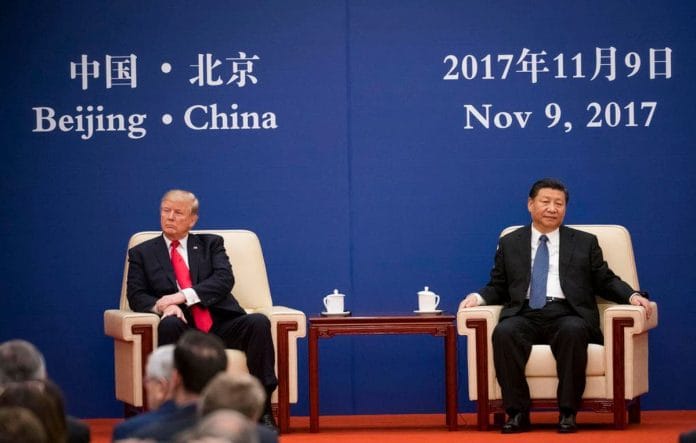The Chinese spokesperson’s post on X, in response to United States President Donald Trump’s threat of tariff war, lays down the contours of a long-drawn cold war in the global power positioning. The Trump administration has been cracking its whip on illegal immigrants and the drug menace emanating from its immediate neighbourhood, allegedly aided and abetted by Beijing. This was expected, as the Trump 1.0 administration had also initiated harsh measures on drug trafficking. It officially designated Mexican drug cartels as national security threats and initiated strong legislative and enforcement steps with particular focus on China.
Trump 1.0 also witnessed a prolonged trade and technology war with Beijing. This led to allegations of intellectual property theft and currency manipulation, resulting in punitive actions against Chinese firms such as Huawei. Trump 2.0 may not be any different.
Going by the present mood in the White House, tariffs on Chinese imports could be as high as 25 per cent, especially on electric vehicles (EV) and steel and aluminium. Besides, punitive actions against export of opioids by China to Mexico, already initiated, could be intensified.
The Chinese spokesperson has posted a warning on X in response to these measures.
“The fentanyl issue is a flimsy excuse to raise U.S. tariffs on Chinese imports. Our countermeasures to defend our rights and interests are fully legitimate and necessary… If the U.S. truly wants to solve the fentanyl issue, then the right thing to do is to consult with China by treating each other as equals,” the post read.
Beijing appears cautious in its approach, giving the impression that it would like to avoid a confrontational attitude from the get-go. However, by asking to be consulted as an equal on the fentanyl issue, Beijing has revealed what it has sought to conceal all these years, that ‘we are equals’.
While the debate on the comparative strength—military, technological, and economic—of the US and China could be inconclusive, there is little doubt that the rivalry is in the open now.
Some history
The disintegration of the Soviet Union and the undeclared conclusion of the Cold War saw the end of bipolarity, albeit briefly, in the international order. It enabled the US to rework its grand strategy in changed geopolitical realities and circumstances. But the euphoria of the new ‘American Century’, with the US as an indomitable superpower, gradually began to fade as several middle powers, aided by regional institutions, emerged on the leaderless global landscape. China, which was waiting for an opportunity, sought to fill this leadership vacuum.
The rise of China and the emergence of Xi Jinping as its strong and undisputed leader changed the way the world looked at the yet-undefined ‘liberal world order’. Many in the US and the West interpreted the emergence of middle powers—and saw the not-so-peaceful rise of China—as a threat to the ‘liberal world order’.
Ironically, it was not these middle powers and China that sought to disengage from the world but Trump. His first administration sought to renegotiate the North American Free Trade Agreement (NAFTA), quit Trans Pacific Partnership (TPP) and withdrew from Paris Agreement, only to mention a few.
Also read: Modi-Trump bonhomie changes nothing for India. Get real, Hindutva fans
Old battle lines
At the end of Trump 1.0 in March 2021, then–US Secretary of State Antony Blinken criticised China, claiming that its actions “threaten the rules-based order that maintains global stability”.
Then–leader of the Chinese delegation, Yang Jiechi, retorted that the US “does not have the qualification to say that it wants to speak to China from a position of strength”.
The US-China battle lines were drawn right from the time of Trump 1.0 and continued through the Biden administration. With a stronger Trump during his second term, it is doubtful if the two would settle their differences peacefully.
“If war is what the U.S. wants, be it a tariff war, a trade war or any other type of war, we’re ready to fight till the end”, read the Chinese spokesperson’s X post.
Yet, ground realities in both capitals appear to be far from being conducive for a full-scale confrontation. The International Monetary Fund (IMF) has lowered China’s economic growth to 4.6 per cent from 5 per cent. However, Premier Li Qiang has announced a GDP growth target of 5 per cent, unconcerned about the looming tariff war, deflationary conditions, weak public spending, and glut in the export market.
The US, on the other hand, is a trade deficit economy, with Current Account Deficit (CAD) widening to 4.2 per cent of GDP. This has exposed its domestic economy to external vulnerabilities.
In the emerging global economic scenario, the US, China, and India, as three major economies, will have to look for ways to resolve trade issues rather than create newer ones.
China will soon host the 25th meeting of the SCO Heads of State Council, an opportunity it will use to forge business alliances to counter Trump’s tariffs.
India, as part of the SCO (Shanghai Cooperation Organisation) and other regional economic platforms, will have to use its best balancing act. It must further its regional trade while dodging Trump’s tariff missiles, and increase exports to the US, where New Delhi has a favourable balance of trade.
It is difficult to become competitive with a low or no tariff regime. However, India will have to increase its manufacturing capabilities by adopting massive automation, lower corporate tax, and greater production and export incentives. Challenging times call for greater and speedy reforms.
Seshadri Chari is the former editor of ‘Organiser’. He tweets @seshadrichari. Views are personal.
(Edited by Prasanna Bachchhav)







Not just SCO, which is a China – Russia led grouping. Even in BRICS, with its steadily growing membership. Being posited as an alternative world view to G 7’s.